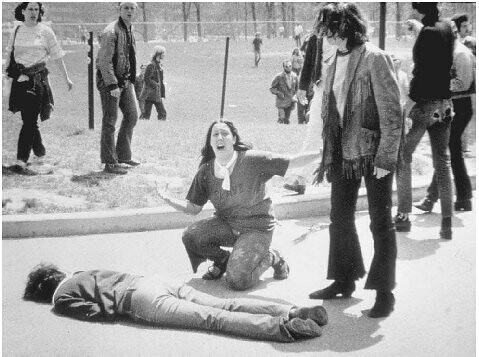Tragedy at Kent State
By Justin Fenicle
The Vietnam War was no ordinary war. The typical sense of wartime patriotism in America proved lacking as the conflict continued. Many Americans did not agree with the Vietnam War and protests began occurring across the country. They involved millions.
College and university students joined the protest movement, increasing numbers. With the change of the Selective Service System’s draft policy, students in the bottom half of their classes faced the possibility of being drafted. This did not sit right with many of them. They held protests, burned draft cards, and chanted slogans like, “Hey, hey LBJ, how many kids did you kill today?”
Protests did not always transpire peacefully. In one case, things turned deadly. The Richard M. Nixon administration’s decision to invade Cambodia on April 30th did not sit well with the students at Kent State. On May 1st, hundreds of students gathered on the commons of Kent State to voice their displeasure with the war and with President Nixon. These protests quickly led to violence in downtown Kent, where cars were being hit with bottles, fires were being spread in the streets and even the Universities ROTC building was burned to the ground by frustrated students. By May 2nd reinforcements were needed by the school as things began to escalate and law enforcement and the university started to lose control. Mayor Leroy Satrom declared a state of emergency, before ordering all the bars in the town closed. Satrom also contacted Ohio Governor James Rhodes seeking assistance. The Ohio National Guard seemed to be the answer to calm the tensions in the area. As for May 3rd, it was a relatively nice day and remained calm, students were even conversing with the nearly 1,000 guardsmen and tensions started to loosen up.
With tensions seeming to loosen up, things suddenly took a turn for the worse. With a planned protest on May 4th, officials thought it would be best to attempt to keep it from happening. The furious protestors were determined and rallied to bring roughly 3,000 people together, this time with National Guardsmen carrying M-1 rifles watching over them. Ohio National Guard General Robert Canterbury ordered the protestors to leave, however the protestors did not back down and began shouting and throwing rocks at the National Guard. The National Guard responded by using tear gas and eventually using their weapons. Some of the National Guard fired into the crowd killing Jeffrey Miller, Allison Krause, William Schroeder and Sandra Scheuer and injuring 9 others. This sent shockwaves throughout the country leaving the school closed for 6 weeks and investigations and trials to be opened by injured Kent State students and their families. Eventually, a settlement was reached in 1979 in which the Ohio National Guard agreed to pay those injured in the events of May 4, 1970 a total of $675,000.


